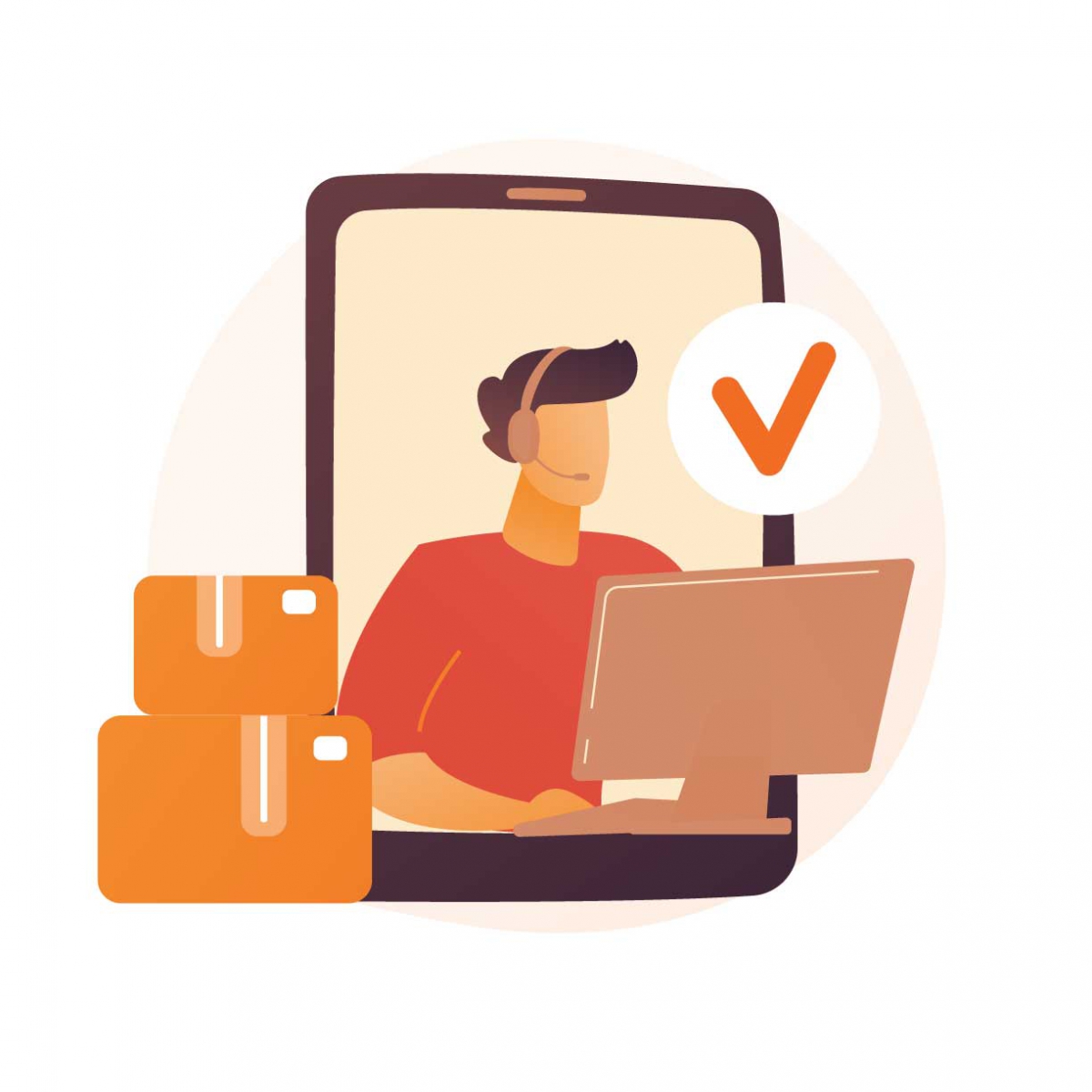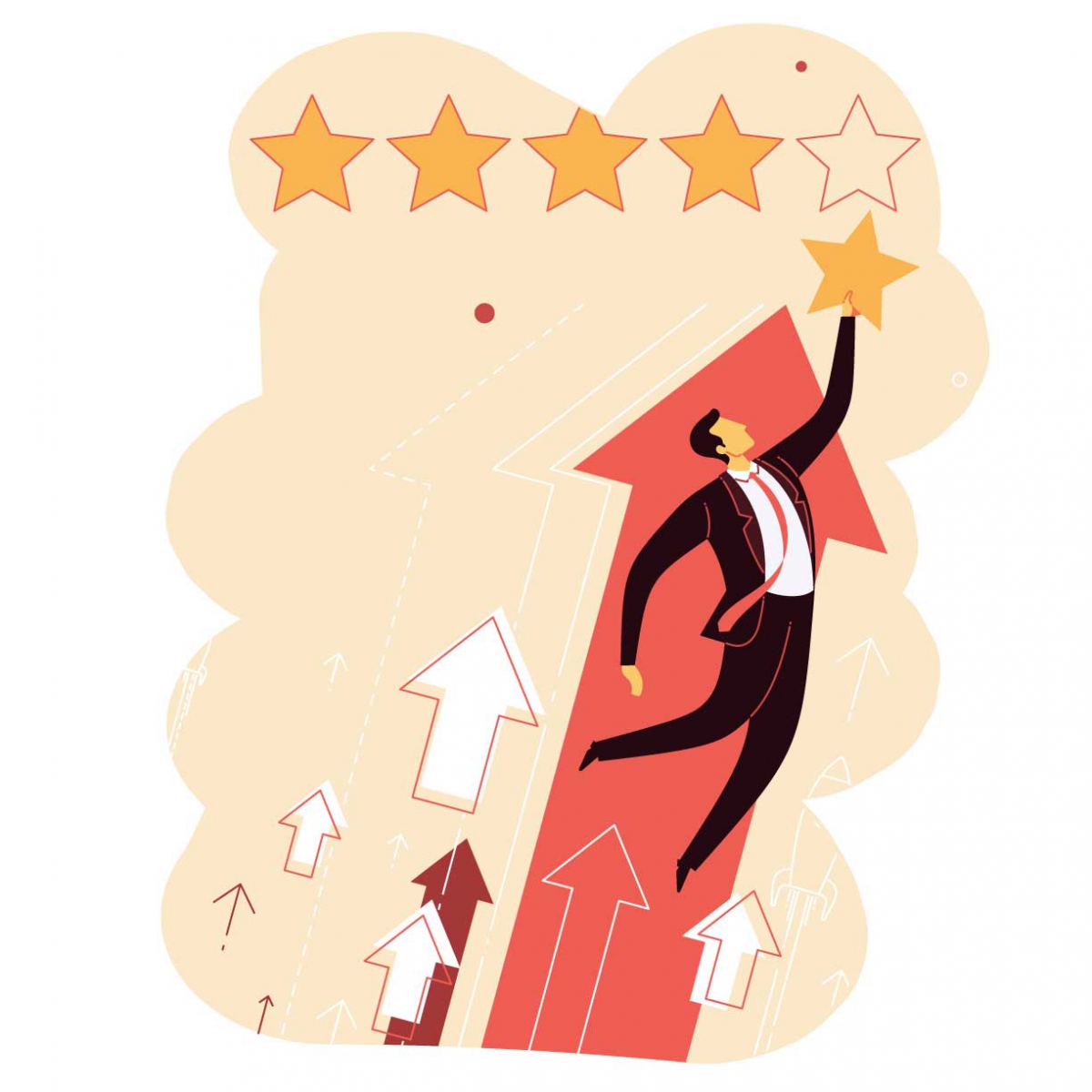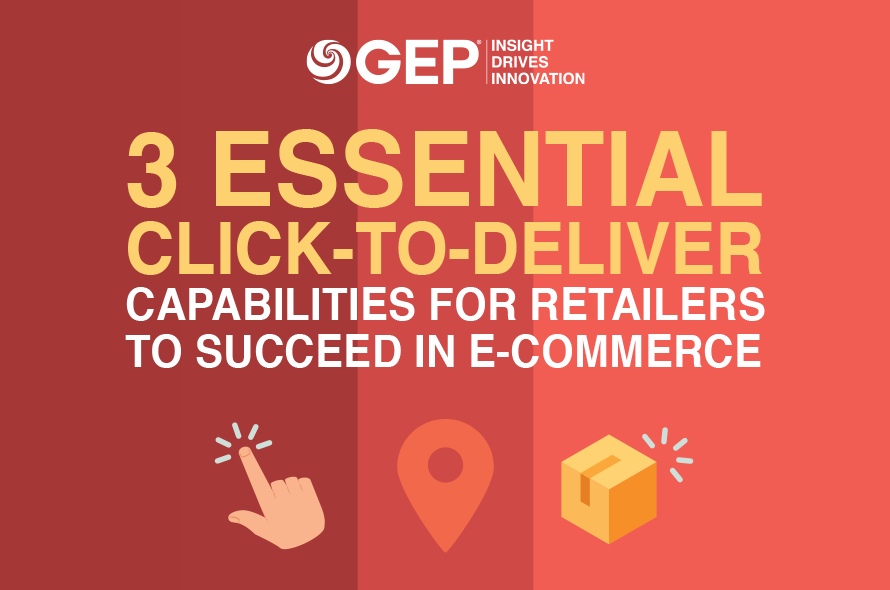E-commerce had been poised to eclipse physical store sales … Then a pandemic-led wave in online shopping surged. Were you ready?
From search engine strategies to digital order fulfillment and logistics, most brick and mortars struggled.
A new GEP paper, 3 Essential Click-to-Deliver Capabilities for Retailers to Succeed in E-commerce, is the ultimate guide for ensuring smooth customer (and digital) experiences ... Learn how to make everything work together seamlessly.
What’s Inside:
- Attracting the right customers for e-commerce profitability
- The perks of customizing the customer experience
- The role of procurement in omnichannel shopper satisfaction
E-commerce sales growth has outpaced that of traditional brick-and-mortar retail in the past decade, and the COVID-19 pandemic has only accelerated this trend. By the end of 2020, average e-commerce sales growth leveled out to 36%, more than 10 times the growth of traditional retail in 2020.1
As e-commerce sales have been steadily increasing over the years, operating income has remained stagnant for leading retailers. Walmart, for example, boasted over 30% growth in e-commerce sales in 2020, while its operating income declined at an average rate of -1.1% over the past three years. Similarly, Kroger’s operating income has declined annually at -1.7% since 2017 despite digital sales growing 59% yearly.
While studies predict that e-commerce sales will overtake physical store sales by 2024 or sooner, physical stores are still needed to boost e-commerce sales.2 Stores provide direct point of contact with the brand and allow customers to see products in person.
Thus, as retailers navigate through this conundrum, three key assumptions to note are:
- Since e-commerce is no longer a key differentiator, retailers should not expect online transactions to augment existing sales. E-commerce will most likely replace traditional channels.
- Cost-to-serve is significantly higher for e-commerce. Customer convenience comes at the retailer’s cost.
- While shopping habits may change, physical stores will continue to boost e-commerce sales and vice versa. Value lies in optimizing hybrid delivery models.
To increase online direct sales, retailers will need to invest in three main “click-to-deliver” capabilities: Customer Acquisition, Customer Omnichannel Experience, and Customer Service and Fulfillment. These complementary capabilities are essential to the e-commerce value chain. In this paper, we focus on the key cost considerations retailers should make when enabling e-commerce in their businesses.
CUSTOMER ACQUISITION: THE LAWS OF CUSTOMER ATTRACTION
A primary cost factor in retail e-commerce is customer acquisition. While overall marketing costs still hover at around 5% to 10% of revenue, e-commerce retail companies invest more in consumer reach efforts — typically search engine optimization (SEO) — as well as other consumer-facing marketing assets.
For e-commerce retailers with over $100 million in annual revenues, an average of 55% of marketing costs are spent on paid media ads, while 39% goes to improving search engine visibility through SEO and ads. Small and low-revenue retailers, on the other hand, typically allocate up to 81% of their marketing budgets to search engines but only half as much on TV ads. Consistently, e-commerce companies reported organic searches as a result of SEO as their most significant source of traffic, attracting around 50% to 70% of customers, according to multiple reports.
With that said, retailers should expect to spend significantly on making their e-commerce platforms discoverable. However, to broaden their customer reach, they also need to:
- Contextualize SEO investments by considering a broader fulfillment strategy. For instance, a retailer’s decision to use Amazon for fulfillment drives strategy regarding the SEO mix across Amazon, Google, and other SEO channels.
- Understand how these algorithms work and look beyond ROI. For instance, sales of Corona Beer were severely impacted in 2020 because the product’s name was similar to “coronavirus.” Marketers need to understand the AI behind these algorithms to optimize their investments.
CUSTOMER EXPERIENCE: WHY YOU NEED TO CUSTOMIZE
When building an online presence and customer-facing shopping platform, e-commerce retailers typically need to consider web design and hosting costs. While retailers can realize cost savings with SaaS or third-party platforms, the trade-off is losing the ability to customize their e-commerce platforms. Customization can be crucial to driving traffic and sales.
WHY IS CUSTOMIZATION IMPORTANT?
- Customization shortens the search-to-transaction process and increases conversion rates, as over 35% of users lose interest if a retailer’s web interface is deemed unattractive.3
- Customized interfaces can automatically configure to match the displays of users’ devices, allowing retailers to tap into the fast-growing mobile e-commerce (m-commerce) market.4
- Customizing web hosting ensures fast load times despite spikes in website traffic, which can drive significant increases in sales and conversion rates.5
Ultimately, retailers should strike a balance between creating immersive e-commerce platforms and spending more on customizing web features. Smaller retailers with limited capital might prefer less costly options such as SaaS or third-party platforms to avoid overspending and disrupting their entire operations. Meanwhile, larger businesses may be able to justify the additional cost of customization with higher sales stemming from intuitive interfaces, responsive designs and faster site speeds.
CUSTOMER EXPERIENCE: GETTING IT RIGHT ON THE BACK END

While technology can increase costs in unexpected ways, it also impacts customer experience. Platforms span marketing, IT, supply chain and customer facing functions, which requires collaboration.
A superior customer experience requires building and integrating back-end infrastructure. This not only enables web platforms to function but also can enhance the customer shopping experience through data and analytics. This data can then be used to manage inventory availability and orders as well as improve pricing and promotions. Ultimately, leveraging data will increase operational efficiency and drive sales.
GEP Retail research suggests that technology spend ranges from 2% to 3% of annual sales, with the main cost categories relevant to e-commerce being IT labor, hardware, services and information security costs. In general, retailers with large brick-and-mortar presences allocate over 25% of technology spend to online channels.6
Technology infrastructure affects operating costs in multiple ways. Currently, these projects are delivered as big one-time initiatives. Budgets are usually cut after implementation, while service delivery models continuously evolve. For instance, one retailer wanted to integrate ShopRunner – an e-commerce order fulfillment service – into its offerings and updated its checkout process to support two-day shipping. While ShopRunner only commits to a two-day delivery, these orders were assigned “expedited shipping” tags in the back-end system, which were money-losing transactions.
CUSTOMER SERVICE: FROM CLICK TO DOOR

Logistics is another key point of differentiation when it comes to customer service. To remain competitive, it is important to carefully manage warehousing, order fulfillment and shipping costs. On average, these costs account for 11% of retailers’ sales revenue, out of which transport and inventory account for 72.1% of this spend. Small retailers typically have higher logistics costs while larger retailers with higher product values have lower logistics costs.7 Given the strategic nature of online customer service, omnichannel retailers should consider logistics as a price strategy as opposed to a cost area.
Take the example of a retailer running a marketing campaign that provides customers with the flexibility to order up to a week before Christmas with free shipping and guaranteed delivery on or before December 25. This serves the marketer’s objective of driving sales volume. However, when it comes to distribution, price inelasticity in the small parcels sector, combined with an increased volume per basket, drives up shipping costs.
As exhibited in this example, shipping cost should be treated as part of the pricing strategy and marketers need to jointly work with supply chain with the same rigor as they do on merchandise pricing strategy. Two-thirds (63%) of online shoppers abandon carts if shipping fees are too high.8 However, as most customers are willing to pay for expedited shipments, the costs recovered from expedited deliveries could potentially be double the cost incurred. Consumer price insensitivity for fast deliveries suggests the ability to convert expedited shipping into a revenue center. This is an opportunity all retailers should explore.
Furthermore, GEP research suggests that two major contributors to high shipping costs are the number of units per package (UPP) shipped and the number of shipments from stores (SFS). For one of GEP’s clients, a decrease in the average UPP by 0.5 units and a 3% increase in SFS orders led to a 15% increase in shipping costs per unit. Having fewer UPP increases the number of packages needed to fulfill customer demand and increases total costs incurred. Similarly, SFS shipments are 25% to 30% more expensive than DC shipments.9 While UPP and SFS are often dictated by customer order patterns, inventory availability and fulfillment approach are entirely on the hands of the retailer.
GEP’s data suggests that small parcel spend — the most expensive fulfillment channel — increases by 13% to 15% each year, driven primarily by heavy reliance on small parcel providers and rising e-commerce volumes.10 In addition to procurement leverage being limited, some retailers face a double whammy if their net fulfillment cost is negative. As such, a common pricing strategy used by 57% of retailers is to implement free shipping at a minimum spend,11 with the market settling at a free shipping threshold of around $35 per order.12
Overall, retailers should manage shipping costs, particularly small parcel spend, to reduce order fulfillment costs. They should examine key drivers such as UPP and SFS to anticipate shipping costs while exploring pricing strategies that drive profits.
WHAT ARE THE LOGISTICS BUSINESS MODEL OPTIONS FOR E-COMMERCE RETAILERS?
- List on Amazon. This comes with challenges across all areas but simplifies delivery methods.
- Fully outsource to a third-party logistics (3PL) partner. This typically leads to faster turnaround times and additional fulfillment expertise. However, retailers without an integrated cross-functional pricing strategy will need to plan for higher supply chain costs during holiday seasons to compete with big movers like Amazon.
- Build your own network. This requires operations management technology such as warehouse management system and enterprise resource planning software, which are used by over 50% of businesses.13 This decision should factor in the sunk cost that comes with idle capacity during non-peak periods as well as the net present value of initial investments. Moreover, another option is to acquire capabilities. For instance, Walmart acquired Jet and Target acquired Shipt to leverage technology platforms and offer expedited delivery options.
- Utilize a pooled infrastructure model. This involves large retailers using spare capacity in their warehouses and distribution centers (DCs) to serve small and midsize enterprises (SMEs) as customers. However, one of GEP’s large apparel clients highlighted the challenges of this strategy: Despite adequate spare capacity and investments in its DCs, seasonal trends in apparel demand (e.g., back-to-school, holidays, etc.) made it challenging for this client to meet SME delivery requirements without negatively affecting delivery times for its own products during peak seasons. Thus, the inability of SMEs to rely on a larger retailer for their logistics needs meant that the warehouse investments needed to support multiple client product lines were near-impossible to justify. For large retailers that can overcome these seasonality challenges, competing with Amazon’s delivery times would still be a tall order due to the lack of a widespread fulfilment network and would be impossible without prioritizing clients’ orders.14
While profitability and operational efficiency are key considerations, retailers should also factor in customer and warehouse locations, demand seasonality, capital structure, product margins and volumes, and long-term growth potential.
CUSTOMER SERVICE: MAKING FOR HAPPIER RETURNS

One of the biggest challenges facing e-commerce retailers is the cost of returns, as e-commerce return rates have grown by 95% over the past five years.15 Pilferage cases in online shops have also driven up fraud costs as a percentage of revenues.
While generous return policies are expected in today’s competitive market, retailers need to take steps to mitigate the misuse of policies. Measures include providing gift receipts, assessing a restocking fee for opened items, requiring contact information, and following up with customers after returns. Other extreme measures utilize AI to monitor language, flag suspicious behaviors, and track fraud by channel or payment method. While these processes are implemented in-house, several retailers have relied on 3PL partners as well when returns significantly increase overall costs.
CONCLUSION
With costs of serving e-commerce customers rising due to COVID-19, retailers should be especially vigilant when managing spend across their Customer Acquisition, Customer Omnichannel Experience and Customer Service and Fulfillment capabilities. When acquiring online customers, they should understand SEO algorithms and align marketing investments with broader fulfillment strategies. When developing immersive online shopping experiences, they should continuously invest in customized web platforms and back-end technologies. Finally, to provide seamless order fulfillment, retailers should explore shipping pricing strategies and implement a logistics business model that best fits their needs.
References
- Stephanie Crets, “How the coronavirus is affecting retailers,” Digital Commerce 360, 12 March 2020 | https://www.digitalcommerce360. com/2020/03/12/coronavirus-affects-online-retailers/
- “In 2024, E-commerce will overtake physical retail,” Generix Group, 27 March 2020 | https://www.generixgroup.com/en/blog/2024-e-commerce-will-overtake-physical-retail
- Erik Devaney, “17 Website and UX Design Statistics That Make the Case for Smarter Web Design,” HubSpot.com, 20 May 2020 | https://blog.hubspot.com/marketing/compelling-stats-website-design-optimization-list
- Andrew Meola, “Rise of M-Commerce: Mobile Ecommerce Shopping Stats & Trends in 2021,” BusinessInsider.com, 30 December 2020 | https://www.businessinsider.com/mobile-commerce-shopping-trends-stats
- “20 Ways to Speed Up Your Website and Improve Conversion in 2020,” The Daily Egg, 22 March 2020 | https://www.crazyegg.com/blog/speed-up-your-website/
- GEP Research
- Jean-Paul Rodrigue, “The Geography of Transport Systems,” Routledge, Taylor & Francis Group, 26 May 2020 | https://transportgeography.org/contents/chapter3/transport-costs/logistic_costs_breakdown/
- “How do consumers think and behave across the purchase journey?” Freefo, 12 November 2020 | https://www.feefo.com/en/business/resources/tips/how-do-consumers-behave-across-the-purchase-journey
- GEP Research
- Ibid
- “2020 Ecommerce Fulfillment Trends Report,” Saddle Creek Logistics, February 2020| https://www.sclogistics.com/wp-content/uploads/2020/02/2020-Ecom-Fulfillment-Trends-1.pdf
- GEP Research
- “Worldwide Enterprise Applications Software Forecast, 2019–2023,” IDC, December 2019 | https://www.idc.com/getdoc.jsp?containerId=US45709619
- GEP Research
- Fran Whittaker-Wood, “What Country Has the Highest Online Shopping Return Rate?” Payments Journal, 13 February 2019 | https://www.paymentsjournal.com/highest-online-shopping-return-rate/

